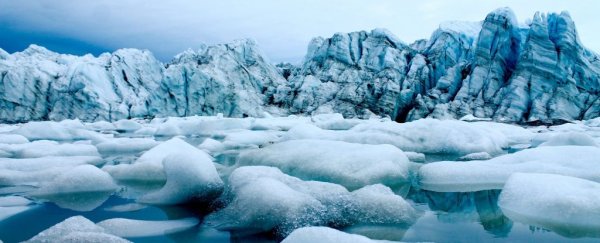Current predictions of ice melt in the Arctic are probably way off. According to an updated model, glaciers in the icy north could be slipping into the sea up to 100 times faster than previously forecasted.
This isn't the first time ice melt predictions have been scrutinized or revised. In 2020, a study found that the current computer simulations of how glaciers interact with the rest of the climate system don't quite match up with reality.
Something in our current models must be incorrect, or the models must be missing something. But what?
Scientists at the University of Texas at Austin (UT) think they've figured out at least part of the problem.
Gaps in data meant that climate scientists have been plugging in observations from accessible glaciers to build models of how all glaciers melt.
But what's happening to the Antarctic ice sheet amid rapid global warming is significantly different from what's occurring to Arctic glaciers.
In Greenland, for example, recent observational research has found that warm ocean water in the nation's fjords is chiseling away at parts of the floating ice sheet from underneath.
This submarine melting is incredibly difficult to measure, especially when you consider how dangerously close to calving icebergs research vessels must get.
To avoid the risky business, scientists have studied Antarctica's more accessible 'glacier tongues' and used the data as a proxy for the Arctic. But while Antarctica and Greenland harbor continental ice sheets, they are not identical twins.
Discerning the different ways these glaciers interact with seawater is urgently needed to improve future climate models.
In 2019, researchers working on floating glacier fronts in Alaska tried to analyze the underlying physics behind ice melt. The team used autonomous kayaks to get as close to the formidable structures as possible, taking precise measurements right where the ice meets the sea at a sharp angle.
Meltwater was measured in the ocean as far away as 400 meters (1,300 feet) from the ice wall, which suggested far more ice was melting quicker than previous estimates – a hundred times greater, to be exact.
Researchers have now used these more accurate measurements to create a better model of Arctic glacier melt in other parts of the northern hemisphere.
"For years, people took the melt rate model for Antarctic floating glaciers and applied it to Greenland's vertical glacier fronts," explains the physical oceanographer Kirstin Schulz from UT.
"It was the best we could do given the limited observations. If it was wrong or right, who knew? But there is more and more evidence that the traditional approach produces too low melt rates at Greenland's vertical glacier fronts."
The updated models use the shape of glaciers and the temperature and salinity of surrounding waters to predict how much submarine ice loss occurs in Greenland. Only with on-the-ground observations can computer-based climate models better resolve regional differences.
Their findings suggest that when Arctic glaciers dip their icy fingers and toes into the sea, they become particularly vulnerable to underwater melt.
Bathed in deep warm waters, sometimes a hundred meters under the surface, their extremities gradually melt away at a constant, weak background rate.
Given that the Arctic is warming four times faster than the rest of the world, researchers suspect submarine melt is worse here than in Antarctica.
"Melting by deep, warm waters increases undercutting of glacier termini, thereby inducing calving and glacier front retreat," Schulz and colleagues write, "leading to a dynamic mass loss that adds to sea level rise."
In a dire future scenario, where all the permanent ice in Greenland melts away, sea levels will rise by more than 7 meters, and studies already suggest 1 foot of sea level rise is locked in.
In fact, some scientists argue Greenland's ice sheet has already passed the point of recovery; others think it could be gone by 2035.
In 2019 alone, half a trillion tonnes of ice were lost from the continent.
Antarctica, in comparison, is losing ice mass at an average rate of about 150 billion tons per year.
The global effects of glacier loss stretch far beyond sea level rise.
When Greenland's ice melts into the ocean, it could halt major ocean currents that help cool our planet's equator.
What's more, as the ice sheet melts, it is starting to release unknown bacteria into the world.
"Ocean climate model results are highly relevant for humankind to predict trends associated with climate change, so you really want to get them right," Schulz says.
If we don't know what's coming down the line, we have no way to prepare.
The study was published in Geophysical Research Letters.
